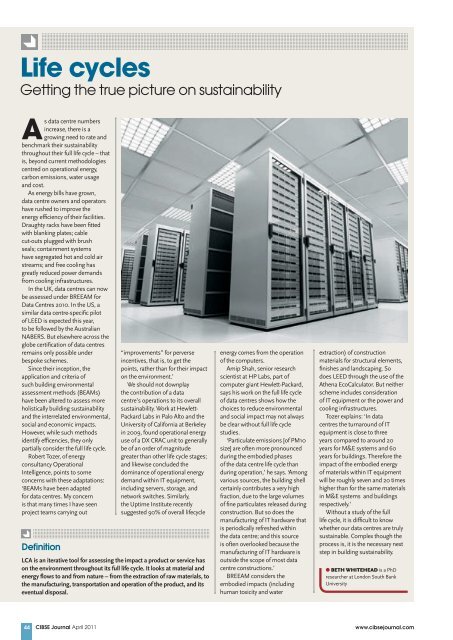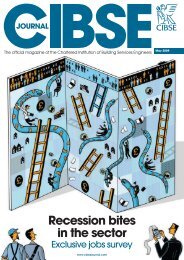You also want an ePaper? Increase the reach of your titles
YUMPU automatically turns print PDFs into web optimized ePapers that Google loves.
Life cycles<br />
Getting the true picture on sustainability<br />
As data centre numbers<br />
incre<strong>as</strong>e, there is a<br />
growing need to rate and<br />
benchmark their sustainability<br />
throughout their full life cycle – that<br />
is, beyond current methodologies<br />
centred on operational energy,<br />
carbon emissions, water usage<br />
and cost.<br />
As energy bills have grown,<br />
data centre owners and operators<br />
have rushed to improve the<br />
energy efficiency of their facilities.<br />
Draughty racks have been fitted<br />
with blanking plates; cable<br />
cut-outs plugged with brush<br />
seals; containment systems<br />
have segregated hot and cold air<br />
streams; and free cooling h<strong>as</strong><br />
greatly reduced power demands<br />
from cooling infr<strong>as</strong>tructures.<br />
In the UK, data centres can now<br />
be <strong>as</strong>sessed under BREEAM for<br />
Data Centres 2010. In the US, a<br />
similar data centre-specific pilot<br />
of LEED is expected this year,<br />
to be followed by the Australian<br />
NABERS. But elsewhere across the<br />
globe certification of data centres<br />
remains only possible under<br />
bespoke schemes.<br />
Since their inception, the<br />
application and criteria of<br />
such building environmental<br />
<strong>as</strong>sessment methods (BEAMs)<br />
have been altered to <strong>as</strong>sess more<br />
holistically building sustainability<br />
and the interrelated environmental,<br />
social and economic impacts.<br />
However, while such methods<br />
identify efficencies, they only<br />
partially consider the full life cycle.<br />
Robert Tozer, of energy<br />
consultancy Operational<br />
Intelligence, points to some<br />
concerns with these adaptations:<br />
‘BEAMs have been adapted<br />
for data centres. My concern<br />
is that many times I have seen<br />
project teams carrying out<br />
Definition<br />
44<br />
“improvements” for perverse<br />
incentives, that is, to get the<br />
points, rather than for their impact<br />
on the environment.’<br />
We should not downplay<br />
the contribution of a data<br />
centre’s operations to its overall<br />
sustainability. Work at Hewlett-<br />
Packard Labs in Palo Alto and the<br />
University of California at Berkeley<br />
in 2009, found operational energy<br />
use of a DX CRAC unit to generally<br />
be of an order of magnitude<br />
greater than other life cycle stages;<br />
and likewise concluded the<br />
dominance of operational energy<br />
demand within IT equipment,<br />
including servers, storage, and<br />
network switches. Similarly,<br />
the Uptime Institute recently<br />
suggested 90% of overall lifecycle<br />
LCA is an iterative tool for <strong>as</strong>sessing the impact a product or service h<strong>as</strong><br />
on the environment throughout its full life cycle. It looks at material and<br />
energy flows to and from nature – from the extraction of raw materials, to<br />
the manufacturing, transportation and operation of the product, and its<br />
eventual disposal.<br />
energy comes from the operation<br />
of the computers.<br />
Amip Shah, senior research<br />
scientist at HP Labs, part of<br />
computer giant Hewlett-Packard,<br />
says his work on the full life cycle<br />
of data centres shows how the<br />
choices to reduce environmental<br />
and social impact may not always<br />
be clear without full life cycle<br />
studies.<br />
‘Particulate emissions [of PM10<br />
size] are often more pronounced<br />
during the embodied ph<strong>as</strong>es<br />
of the data centre life cycle than<br />
during operation,’ he says. ‘Among<br />
various sources, the building shell<br />
certainly contributes a very high<br />
fraction, due to the large volumes<br />
of fine particulates rele<strong>as</strong>ed during<br />
construction. But so does the<br />
manufacturing of IT hardware that<br />
is periodically refreshed within<br />
the data centre; and this source<br />
is often overlooked because the<br />
manufacturing of IT hardware is<br />
outside the scope of most data<br />
centre constructions.’<br />
BREEAM considers the<br />
embodied impacts (including<br />
human toxicity and water<br />
extraction) of construction<br />
materials for structural elements,<br />
finishes and landscaping. So<br />
does LEED through the use of the<br />
Athena EcoCalculator. But neither<br />
scheme includes consideration<br />
of IT equipment or the power and<br />
cooling infr<strong>as</strong>tructures.<br />
Tozer explains: ‘In data<br />
centres the turnaround of IT<br />
equipment is close to three<br />
years compared to around 20<br />
years for M&E systems and 60<br />
years for buildings. Therefore the<br />
impact of the embodied energy<br />
of materials within IT equipment<br />
will be roughly seven and 20 times<br />
higher than for the same materials<br />
in M&E systems and buildings<br />
respectively.’<br />
Without a study of the full<br />
life cycle, it is difficult to know<br />
whether our data centres are truly<br />
sustainable. Complex though the<br />
process is, it is the necessary next<br />
step in building sustainability.<br />
l Beth Whitehead is a PhD<br />
researcher at London South Bank<br />
University<br />
<strong>CIBSE</strong> <strong>Journal</strong> April 2011 www.cibsejournal.com







